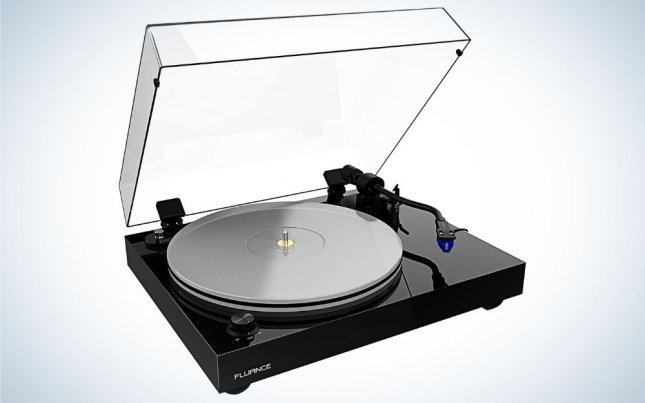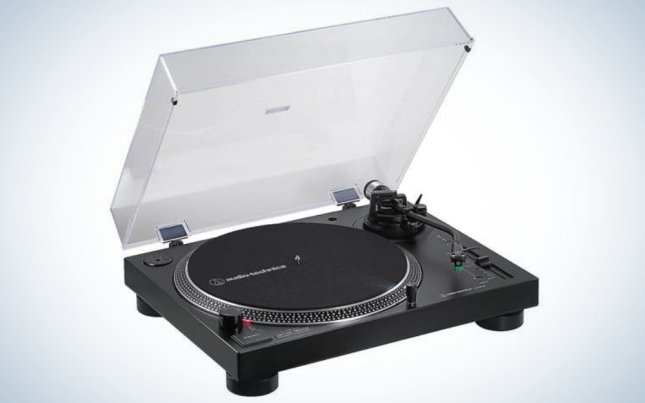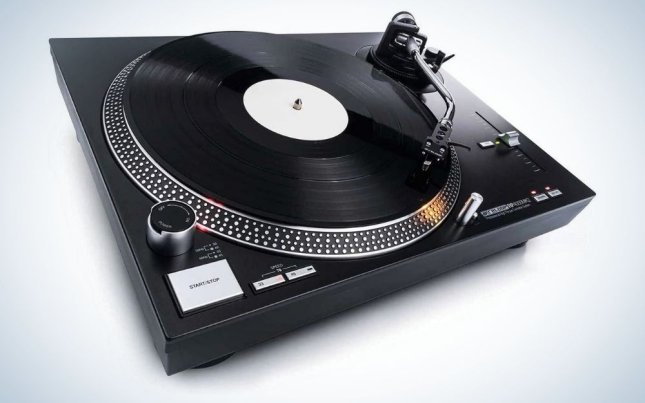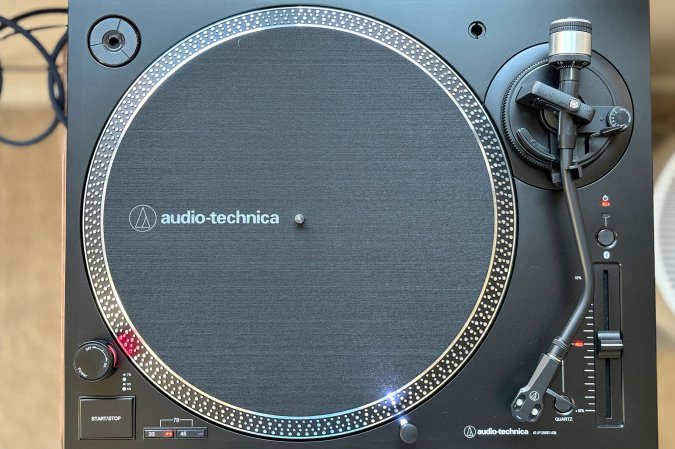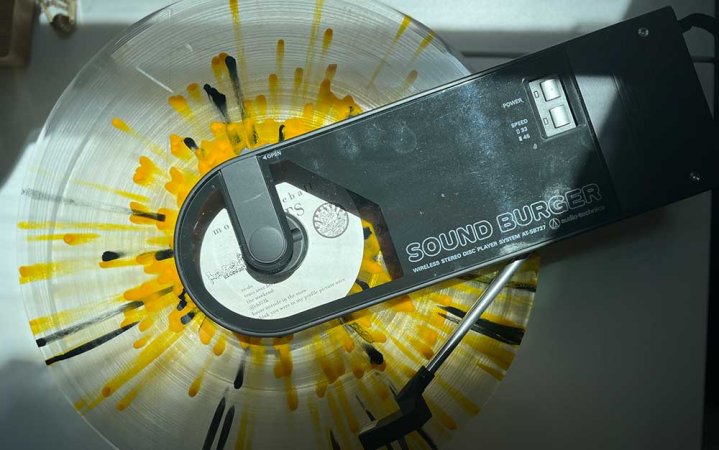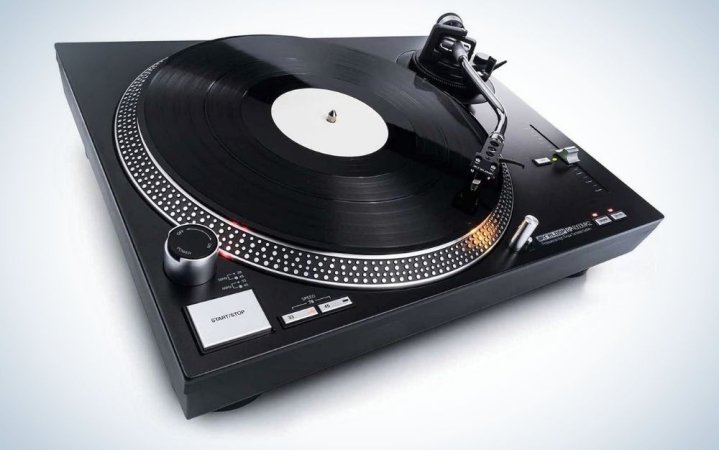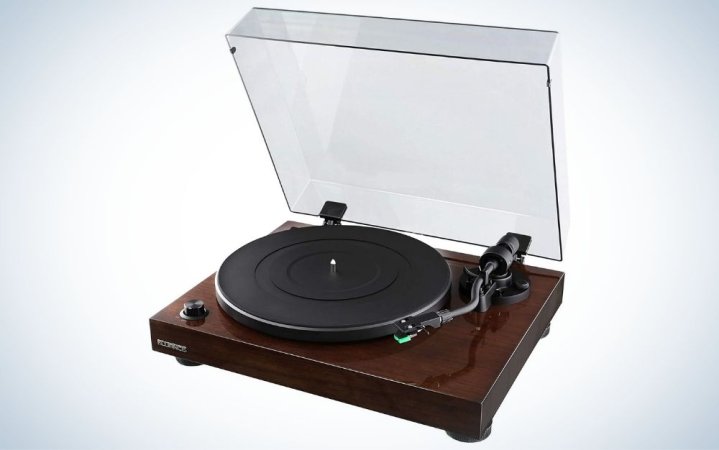We may earn revenue from the products available on this page and participate in affiliate programs. Learn more ›
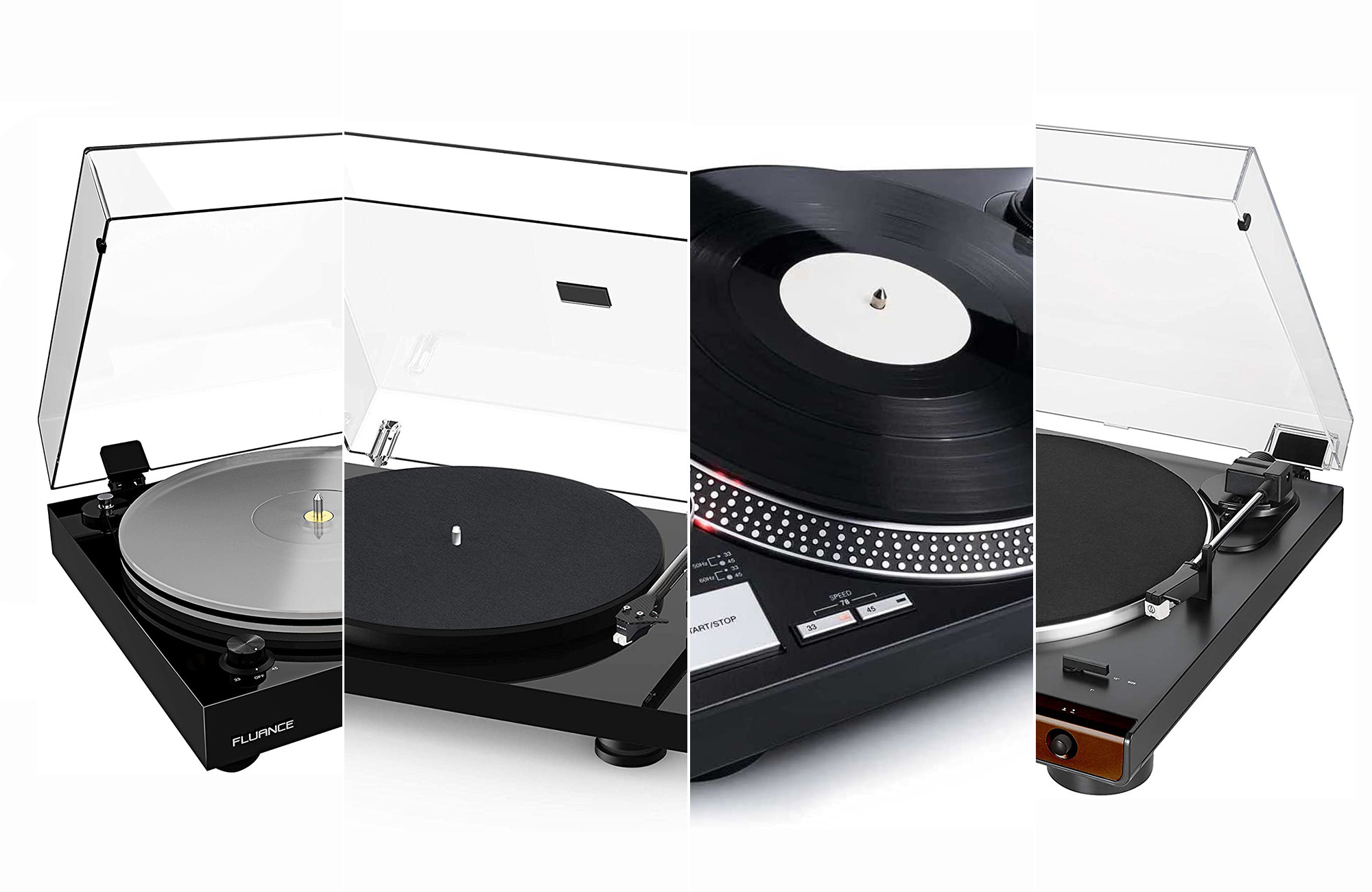
You could have the sweetest vinyl collection, but it won’t do you much good without a reliable turntable to play them on. Your turntable and its needle (like our best overall pick, the Fluance RT85) are arguably the most critical components in your analog sound system, translating the grooves of a record into an audio signal. Even if you have a quality amplifier or receiver and excellent speakers further down your sound system’s signal chain, they’ll only serve to accurately reproduce a subpar signal if you’re using a low-quality source. With that in mind, we’re recommending a selection of the best turntables under $500 here that you can feel assured will translate those grooves so that your system plays the music the way it was intended to sound.
- Best overall: Fluance RT85
- Best Bluetooth: Audio-Technica AT-LP120XBT-USB
- Best portable: Audio-Technica AT-SB727 Sound Burger
- Best for DJs: Reloop 4000 MK2
- Best for beginners: Audio-Technical AT-LP60X-BW
- Best budget: Fluance RT81
- Best for audiophiles: Pro-Ject Debut Carbon Evo
How we selected the best turntables under $500
The best turntables under $500 offer a vast array of options, ranging from cheap beginner models to uber-expensive devices built for audiophiles. Here, we chose to focus on what you might characterize as the lower midrange of the market. We capped the prices at around $500 because you can get an excellent model to provide the foundation for your sound system. And while that mark may not sound budget, it’s still relatively low compared to the $1,000 and higher turntables in the hard-core audiophile market. We also left out sub-$100 turntables to keep the quality level at the bottom of the list in a respectable place. We considered dozens of models, relying on personal experience and spec comparisons, peer recommendations, user feedback, and trusted editorial reviews to narrow our list of record players we’d love to plug into some turntable-friendly speakers.
The best turntables under $500: Reviews & Recommendations
Once you understand the differences between different turntable types and features and you factor those in with your budget, making a turntable selection shouldn’t be too difficult. We hope our list of the best turntables under $500 will simplify your decision-making process.
Best overall: Fluance RT85
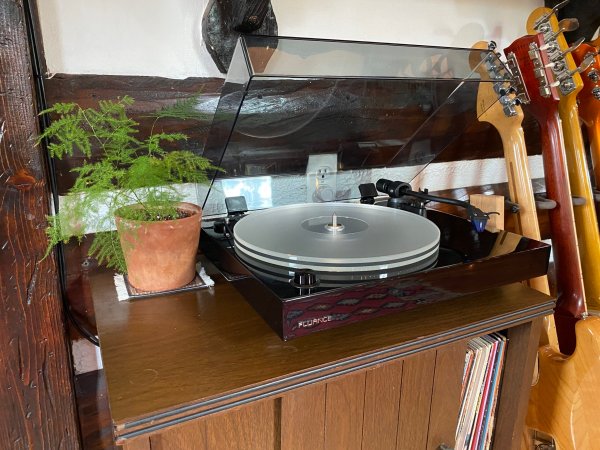
Pros
- “Reference-quality” sound
- Heavy-duty plinth and platter keep vibrations at bay
- Nude-diamond cartridge for accurate pickup
Cons
- Requires some assembly
- Larger and heavier than average
Why it made the cut: The RT85 offers excellent design, build quality, components, and sound. It’s a deal at this price.
Specs
- Turntable operation: Semi-automatic
- Cartridge Type/Model: Moving magnet/Ortofon: 2M Blue
- Phono preamp: No
- Speeds: 33-1/3 and 45 RPM
- Drive Method: Belt
Our top pick comes in right under the cutoff for the best turntables under $500, and it’s worth every penny. The RT85 is an example of Fluance’s talent for designing and building gear that can go toe-to-toe with higher-priced models from its competitors. Available in white, walnut, and bamboo finishes, it looks expensive. More importantly, though, it sounds fantastic, particularly when paired with other quality components. Bigger and heavier than your average turntable, its MDF wooden plinth features three large, adjustable rubber feet, which, along with the weight and density of the plinth, help limit external vibrations. Fluance outfitted the two-speed, belt-driven unit with a heavy, translucent acrylic platter. Its mass and density help keep the speed consistent.
Like most high-quality turntables, the RT85 doesn’t have a built-in preamp. You’ll need to pair it with an outboard phono preamp or a receiver with a phono input. But the results are worth it. Its Ortofon 2M Blue cartridge features a “nude” diamond stylus for the most accurate tracking. The RT85 offers clear sound, a wide stereo image, and a whisper-quiet operation. Our reviewer used the term “reference experience” to describe listening to records on the RT85, and you can read more comprehensive hands-on impressions of its features, sound, and user experience.
Best Bluetooth: Audio-Technica AT-LP120XBT-USB
Pros
- Digital and analog connection options
- USB port for copying albums
- Line or phono analog outputs
Cons
- Dust cover vulnerable to scratches
Why it made the cut: The AT-LP120XBT-USB offers excellent Bluetooth implementation, A/D conversion to USB, and line and phono analog outputs.
Specs
- Turntable operation: Manual
- Cartridge Type/Model: Dual moving magnet/Audio-Technica AT-VM95e
- Phono preamp: Yes
- Speeds: 33-1/3, 45, and 78RPM
- Drive Method: Direct
The AT-LP120XBT-USB is compatible with virtually any music system, thanks to its variety of outputs, both digital and analog. On the digital side, you can pair the unit with Bluetooth speakers, allowing you to enjoy your music wirelessly. Listeners can also use the USB port for copying your albums digitally to a computer. In the analog domain, the built-in preamp allows you to connect the turntable to line-level inputs on a preamp or receiver. You can also bypass the preamp to connect to an external unit. Thanks to its multiplicity of output types, the AT-LP120XBT-USB is a turntable you can hold onto for a long time, even if you completely change the sound system around it.
More dusty than digital? The AT-LP120XBT-USB will appeal to music listeners and entry-level DJs. Not only is its vibe reminiscent of classic DJ turntables (think the Technics SL-1200mk7), but it’s also got many of the features DJs want, such as a quartz-controlled +/-10% pitch control, a start/stop button, stroboscopic platter, and a direct-drive design.
If you’re more concerned with budget than rocking beats, Audio-Technica also offers a more affordable belt-driven Bluetooth option, the AT-LP60XBT-BK. But if it’s the best value you want, you’d be hard-pressed to find better connectivity among the best turntables under $500 than what’s offered by the AT-LP120XBT-USB.
Best portable: Audio-Technica AT-SB727 Sound Burger
Pros
- Bluetooth connectivity
- A great piece of record history
- Compact
Cons
- Tonearm fixing screw is easy to lose
- Requires a flat surface to use
Why it made the cut: Whether it’s on your bookshelf or a picnic bench, this playful platter has the turntable history and modern features to make any vinyl lover’s mouth water.
Specs
- Turntable operation: Manual
- Cartridge Type/Model: VM
- Phono preamp: No
- Speeds: 33-1/3 and 45 RPM
- Drive Method: Belt drive
It’s Audio-Technica again, but this time, instead of a tabletop model that packs in the latest connectivity, it’s a refreshed classic made for portability. If a typical turntable design bores you, or you’re looking for something that lets you take your records for a spin without weighing you down, consider the Audio-Technica AT-SB727 Sound Burger. First released in 1983, the Sound Burger—originally called “Mister Disc” in the US—was made for on-the-go analog enjoyers. A Walkman for LPs, so to speak, it was battery-operated and came with a pair of foldable headphones. It was brought back in 2022 with upgrades to celebrate Audio-Technica’s 60th anniversary and a limited run of 7,000 red units quickly sold out. One year later, the company announced that the retro-modern disc player would permanently return to AT’s turntable line-up, available in Black or Yellow for $199.
Instead of a battery bay and foldaway headphones, the Sound Burger now comes with a USB-C charging cable and Bluetooth connectivity—so consider a portable speaker. It also includes a 3.5mm male to dual RCA male audio cable in case you want to connect your nice speakers. Regardless of your preferred transducer choice, you will need a pair of external speakers for it to work. And it can work. The clamshell contraption will spin 33-1/3 & 45 RPM records for 12 hours on a full charge and includes a handle to take it anywhere to sandwich some colored vinyl while you enjoy a flavorful sub. It has a belt-drive system and DC motor for stable rotation, although you do have to keep it on a flat surface. Sadly, that means it’s more suited for a picnic table than on the grass. And, just like the original, you can connect headphones to enjoy the music for yourself. I love owning something that’s a conversation starter, a decor piece, and an object that just plain works. However, the tonearm fixing screw, which keeps the tonearm in place while you’re in transit, is small and easy to lose. Ensure you put it in your pocket or leave it in a visible space when using the Sound Burger.
Best for DJs: Reloop 4000 MK2
Pros
- High-torque motor for faster speed changes
- Reverse and pitch reset features added
- Shock-absorbing feet increase isolation
- Improved needle illumination
Cons
- Sound damping could be better
Why it made the cut: It’s solidly built, offers all the critical DJ features, and costs under $400.
Specs
- Turntable operation: Manual
- Cartridge Type/Model: Dual moving magnet/Ortofon OM Black
- Phono preamp: Yes
- Speeds: 33-1/3, 45, and 78RPM
- Drive Method: Direct
This quartz-driven, high-torque, direct-drive turntable is purpose-built for DJs who need meticulous accuracy for matching tracks. Reloop improved the MK2 version with capabilities like quartz-lock tempo reset and reverse play. The onboard pitch control allows for +/-8-percent and +/-16-percent changes. The higher torque in the direct-drive motor helps the turntable get back up to speed faster and more cleanly.
Reloop redesigned the top panel and equipped it with tactile buttons. It also added extendible needle illumination, which allows you to use the aluminum target light to see the needle position when you’re in a dark environment. The RP-4000 MK2 features robust construction and new shock-absorbing feet, which help limit vibrations—a helpful feature when you’re working in a club full of dancing people and massive speakers. The tonearm on the RP-4000 MK2 is statically balanced and includes a hydraulic lift and anti-skating mechanism.
With its extensive feature set and solid build quality, the RP-4000 MK2 is a capable DJ turntable at an affordable price point. If you’re willing to spend a bit more, Reloop’s RP-7000 MK2 offers even more capabilities while still being a bargain compared to the top-tier Technics that shows in the linerage of the A-T above and this Reloop.
Best for beginners: Audio-Technical AT-LP60X-BW
Pros
- Best entry-level deck on the market
- Excellent value.
- Defeatable preamp
Cons
- No Bluetooth output
Why it made the cut: It outperforms everything in its price range.
Specs
- Turntable operation: Automatic
- Cartridge Type/Model: Dual moving magnet/ATN3600L
- Phono preamp: Yes
- Speeds: 33-1/3, 45 RPM
- Drive Method: Belt
An updated version of the AT-LP60, this belt-drive turntable is easy to set up and operate and can more than hold its own with similarly priced or even higher-priced competitors. The AT-LP60X-BW features an onboard phono preamp, so you can connect it to sound systems that have no phono inputs available. If you don’t need the preamp, you can switch it off.
One area where you can see how A-T kept the price down is connectivity: It only offers a single stereo 3.5mm output. However, the turntable comes with an RCA breakout cable for connecting to other components in your system.
The most significant changes in this updated version include a newly designed tonearm base and headshell, which Audio-Technica says will improve tracking and decrease resonance. A-T externalized the power supply, which reduces the chance for electrical interference getting into the audio signal. In the cartridge department, A-T offers one of its own, the dual-moving magnet ATN3600L. If you’re new to vinyl or just looking for a quality turntable at a low price, you won’t go wrong with the AT-LP60X-BW.
Best budget: Fluance RT81
Pros
- Quality AT95E cartridge
- Phono and line output
- Solid wood plinth
Cons
- No automatic return
- Plastic tonearm
- No Bluetooth
Why it made the cut: A lot of turntable for the money.
Specs
- Turntable operation: Auto Stop and Start
- Cartridge Type/Model: Dual moving magnet/ATN95E
- Phono preamp: Yes
- Speeds: 33-1/3, 45 RPM
- Drive Method: Belt
This unit is an excellent choice if you want a low-priced option as a step up from a beginner model. The unit features an onboard preamp that you can switch on and off, giving you the flexibility to connect with various components. Fluance equipped it with an Audio-Technica ATN95E cartridge, which offers solid sonics. If you want to up the quality at some point, you can replace it with a higher-end cartridge.
The RT81’s plinth is solid wood with a spiffy-looking walnut finish. It’s relatively heavy, which helps it withstand vibrations. On the downside, its tonearm is plastic. Although the turntable doesn’t offer fully automatic operation, it features auto-start and -stop. The turntable starts when you lift the tonearm and move it over the record. When a record reaches the end, it stops (although you still must put the tonearm back manually). These are just some of the features that make this our best value for vinyl.
Best for audiophiles: Pro-Ject Debut Carbon EVO
Pros
- Exceptional sound quality for the money
- Additional isolation of platter helps reduce vibrations even more
- Electronic 3-speed switching
- Lots of color choices
Cons
- Relatively pricey
Why it made the cut: Yes, we went slightly over our price point for this turntable, but it was the clear choice near this category. Hey, we made the rules, so we can bend them a little.
Specs
- Turntable Operation: Manual
- Cartridge Type/Model: Moving Magnet/Sumiko Ranier
- Phono Preamp: No way
- Speeds: 33-1/3, 45, and 78RPM
Pro-Ject’s first new Debut model in 10 years, this turntable offers a stripped-down design aesthetic and a dedicated focus on excellent sound quality. Hand-built in the Czech Republic, the belt-driven Carbon EVO features a heavier platter than its predecessors, with extra internal damping to isolate it from the surface on which it rests.
The company designed the Carbon EVO with height-adjustable metal feet for precise leveling and to further reduce vibrations. Unlike previous Debut models, the Carbon EVO has a switch for changing speeds—it used to require removing and changing the belt. What’s more, the company has also added a 78RPM setting. Listeners can choose from nine different hand-painted finishes.
But the sound is the driving factor in the design of this turntable. Thanks to its heavy plinth, improved motor suspension, Sumiko Ranier cartridge (models outside the US may get an Ortofon 2M Red cartridge instead), and a one-piece carbon-fiber tonearm, the Debut Carbon EVO delivers it, big time. It provides generous bass, an exceptionally warm midrange, and plenty of high-end. You’ll have to supply your own preamp, but, hey, that’s the way any audiophile would want it. Hopefully, you’ll be able to find a sale on this unit sometime soon, so it actually qualifies as one of the best turntables under $500. Until then, it’s the top pick around that price and the best splurge before you spend much, much more. And if you just can’t wait for a discount, Pro-ject offers other premium approachable belt-driven options, such as the $399 manual T1 or automatic A1.
What to consider when shopping for the best turntables under $500
You’ve got several decisions beyond price to make when buying one of the best turntables under $500—or any turntable, for that matter. Do you want a belt-drive or direct-drive operation? A phono, line-level, USB, or Bluetooth output—or a combination thereof? Automatic or manual operation? Do you want it to integrate into your existing stereo system or are you building from scratch? Do you plan to DJ with your turntable? We’ll get into specifics on those issues here.
What are the significant parts of a turntable?
The base of a turntable is called the plinth. An ideal plinth is made of wood and is dense enough to reduce the vibrations it picks up from the surface on which it’s sitting. The motor and other circuitry typically reside inside the base. A spinning cylinder called the platter sits on top of the base and provides a platform for the record.
The tonearm attached to the base houses the cartridge and the stylus. The stylus is the needle that vibrates as it travels through a record’s grooves. The tonearm may or may not have a cue lever, which raises and lowers it remotely. If there is no cue lever, the cartridge will have a small handle which you lift the tonearm on and off the record.
When the stylus touches the grooves of a spinning record, it creates vibrations that travel to the cartridge, which amplifies them into an electrical signal. In a turntable with no preamp, that electrical signal travels to the turntable outputs and will require an external preamp (either standalone or in a receiver) to bring it up to line level. With a built-in preamp, the signal goes from the cartridge into the preamp, and the turntable outputs it at line level.
Is it true that built-in phono preamps are inferior to external ones?
For the most part, you’ll get better quality by using a separate phono preamp or an A/V receiver that includes one rather than a built-in preamp. Turntables with built-in preamps tend to be cheaper than those without. A built-in preamp typically indicates cheaper components across the board. No self-respecting audiophile would come near a turntable with a built-in preamp, but typical listeners may find them totally fine.
Built-in preamps make it possible to use a smaller system—for example, just a turntable and a pair of powered speakers (such as the Klipsch the Nines). They’re also necessary on certain kinds of turntables, such as ones with digital outputs (which require line-level signals) or models built for DJs. As a result, four of the six turntables in this roundup have preamps built-in, although most offer options to bypass them.
What’s the difference between belt-drive and direct-drive turntables?
A belt-drive turntable has a motor adjacent to the platter. The motor has a belt attached that goes around the circumference of the platter and back. When the motor turns, the belt moves, causing the platter to spin. Depending on the turntable’s design, the motor and belt may be visible or hidden inside the base.
On a direct-drive turntable, the motor is located under and attached to the center of the platter. When the motor spins, the platter does, as well.
The most significant advantage to a belt-drive turntable is that the motor is isolated from the platter. As a result, the cartridge is less likely to pick up machine noise than on a direct drive model where the motor is underneath the center of the record.
However, direct-drive turntables can provide more precision when it comes to speed. Many have a quartz-lock feature that controls platter speed with a quartz-crystal oscillator to ensure the record plays at the correct, consistent speed. Two of the turntables we’re covering here, the Audio-Technica AT-LP120XBT-USB and the Reloop 4000 MK2, are direct-drive models, and both offer quartz-lock features.
FAQs
Turntables are like wine or cars—you get what you pay for, at least in many cases. Generally speaking, the more expensive the turntable, the better the quality of its components and, thus, the better the sound. One of the most important parts is the cartridge. As you get higher in price, the cartridge’s quality, and therefore the overall sound quality improves significantly. The ability of the plinth and platter to limit vibrations is also essential. Then there’s the accuracy of the turntable from a speed standpoint. Inexpensive belt-drive turntables sometimes run slightly off-speed when they get worn out. Some companies do better than others at economizing while keeping quality relatively high.
You certainly don’t need a turntable with built-in speakers, as those are usually of low quality. But unless the turntable has a Bluetooth output and you’re listening on headphones, you will need the best speakers for music within your budget. If your turntable has a line output or Bluetooth output, you can connect it directly to powered speakers (I’m a fan of the Fluance Ai41 if you’re on a budget). The most common configuration, however, is to connect your turntable into a receiver with phono inputs or through a standalone preamp and then a receiver or amplifier. The amplified signal is then routed to your passive speakers from the amp or receiver where it’s turned into audio waves.
It depends on how you define “better.” Technically speaking, the 16-bit, 44.1kHz digital audio that a CD player produces has a superior dynamic range (distance between the quietest and loudest possible sound), better stereo separation, and less distortion than vinyl. But listening to music is much more subjective than that, and many listeners feel that vinyl just sounds warmer, more organic and lifelike. Ironically, that warmth comes from vinyl’s imperfections and the CD’s “sterility” from its more accurate and quieter reproduction.
Final thoughts on the best turntables under $500
- Best overall: Fluance RT85
- Best Bluetooth: Audio-Technica AT-LP120XBT-USB
- Best portable: Audio-Technica AT-SB727 Sound Burger
- Best for DJs: Reloop 4000 MK2
- Best for beginners: Audio-Technical AT-LP60X-BW
- Best budget: Fluance RT81
- Best for audiophiles: Pro-Ject Debut Carbon Evo
If you’ve decided to take the plunge and get a turntable—whether it’s for the first time or you’re moving back to vinyl after many years with CDs—we’re confident you’ll be able to find a model that works for your needs from the best turntables under $500 we’ve recommended here. These six turntables offer a range of prices and capabilities and should satisfy any listener except perhaps hard-core audiophiles.
